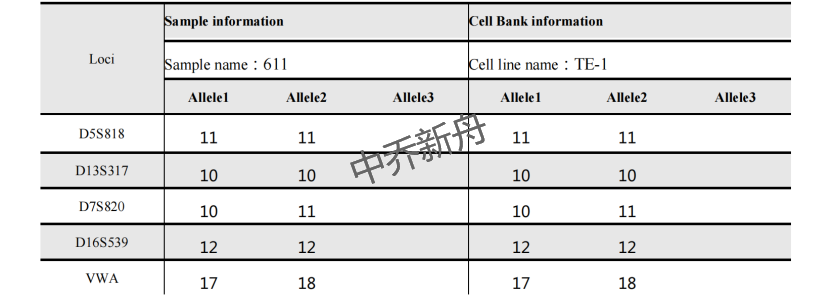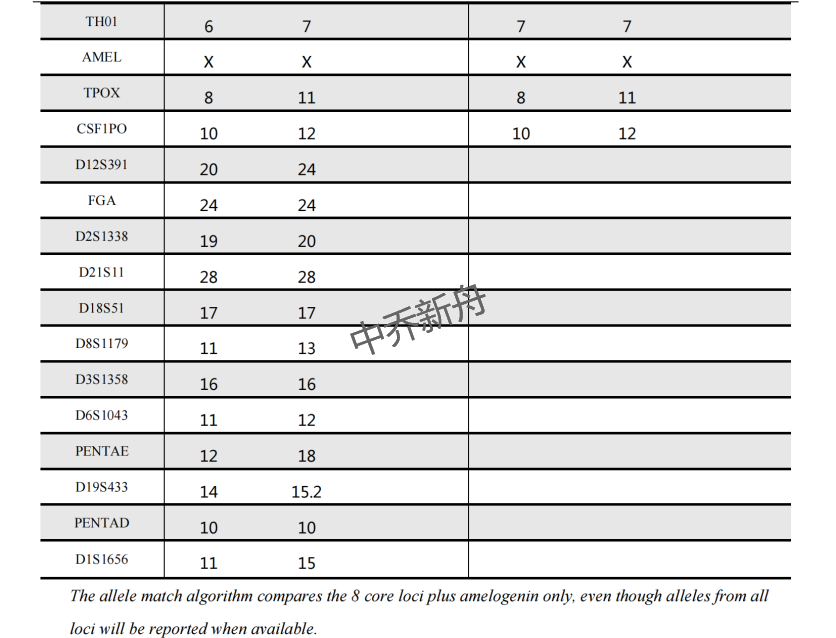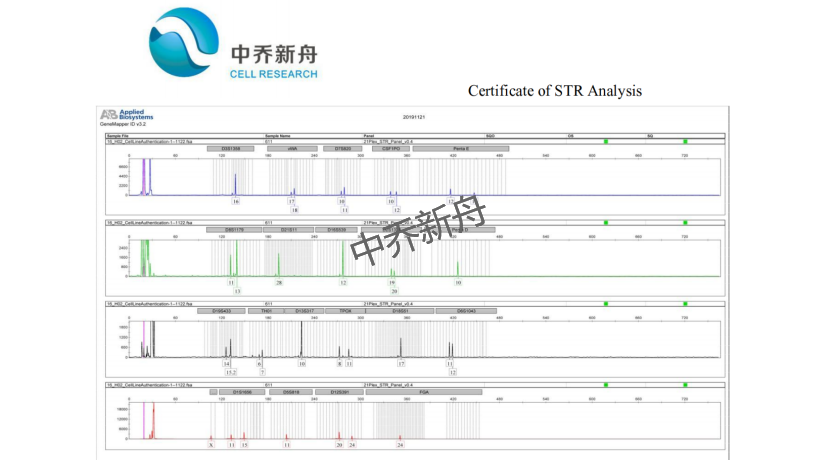|
产品名称 |
TE-1人食管癌细胞 |
|
货号 |
ZQ0235 |
|
产品介绍 |
TE-1细胞是从一位患有食管鳞癌的58岁患者体内分离建系,是一种高度分化的上皮细胞样食管鳞状癌细胞株。该细胞被广泛应用于研究食管癌的发生、发展和治疗等方面。具有独特的生物学特性。而,由于TE-1细胞的生物学特性或基因表达模式存在限制,使其无法成功移植到裸鼠体内进行进一步的研究或实验。 TE-1细胞在食管癌研究领域中是一个重要的细胞模型,可用于癌症治疗研究。它们的生长特性和基因表达信息可以用于深入了解食管癌的生物学过程。通过在TE-1细胞中进行药物筛选,可以快速识别对食管癌具有潜在疗效的化合物。此外,利用TE-1细胞研究食管癌发生和发展的分子机制,有助于揭示潜在的治疗靶点。
注意事项: |
|
种属 |
人 |
|
性别/年龄 |
男/58岁 |
|
组织 |
食道 |
|
疾病 |
食管鳞状细胞癌 |
|
细胞类型 |
肿瘤细胞 |
|
形态学 |
上皮细胞 |
|
生长方式 |
贴壁 |
|
倍增时间 |
大约60小时 |
|
培养基和添加剂 |
RPMI-1640(中乔新舟 货号:ZQ-200)+10%胎牛血清(中乔新舟 货号:ZQ0500)+1%双抗(中乔新舟 货号:CSP006) |
|
推荐完全培养基货号 |
|
|
生物安全等级 |
BSL-1 |
|
STR位点信息 |
Amelogenin :X CSF1PO: 10,12 D2S1338: 19 D3S1358: 16 D5S818: 11 D7S820 :10,11 D8S1179 :11,13 D13S317 :10 D16S539: 12 D18S51: 17 D19S433 :14,15.2 D21S11 :28 FGA: 24 PentaD: 10 PentaE: 12,18 TH01 :7 TPOX: 8,11 vWA: 18 D1S1656: 11,15 D6S1043: 11,12 D12S391: 20 |
|
培养条件 |
95%空气,5%二氧化碳;37℃ |
|
抗原表达/受体表达 |
*** |
|
基因表达 |
*** |
|
保藏机构 |
KCB; KCB 200737YJ RCB; RCB1894 |
|
供应限制 |
仅供科研使用 |
|
货号 |
ZM0235 |
|
发货规格 |
活细胞:T25培养瓶*1瓶或者1ml 冻存管*2支(细胞量约为1x10^6 Cells/Vial)二选一 |
|
发货形式 |
活细胞:常温运输;冻存管:干冰运输 |
|
储存温度 |
活细胞:培养箱;冻存管:液氮罐 |
|
产地 |
中国 |
|
供应限制 |
仅供科研使用 |
论文标题: miR-28-5p targets MTSS1 to regulate cell proliferation and apoptosis in esophageal cancer
DOI: 10.1093/abbs/gmaa059
发表时间: 2020-08-05
期刊: ACTA BIOCHIMICA ET BIOPHYSICA SINICA
影响因子: 2.836
货号: ZQ0235
产品名称: TE-1 cells
原文链接: https://academic.oup.com/abbs/article-abstract/52/8/842/5869218
论文标题: Casticin inhibits esophageal cancer cell proliferation and promotes apoptosis by regulating mitochondrial apoptotic and JNK signaling pathways
DOI: 10.1007/s00210-018-1574-5
发表时间: 2018-11-17
期刊: NAUNYN-SCHMIEDEBERGS ARCHIVES OF PHARMACOLOGY
影响因子: 2.238
货号: ZQ0235
产品名称: TE-1 cells
原文链接: https://link.springer.com/article/10.1007/s00210-018-1574-5
论文标题: β-elemene suppresses the malignant behavior of esophageal cancer cells by regulating the phosphorylation of AKT
DOI: 10.1016/j.acthis.2020.151538
发表时间: 2020-03-14
期刊: ACTA HISTOCHEMICA
影响因子: 2.107
货号: ZQ0235
产品名称: TE-1 cells
原文链接: https://www.sciencedirect.com/science/article/pii/S0065128120300374
PubMed=520749; DOI=10.20772/cancersci1959.70.5_575
Nishihira T., Kasai M., Mori S., Watanabe T., Kuriya Y., Suda M., Kitamura M., Hirayama K., Akaishi T., Sasaki T.
Characteristics of two cell lines (TE-1 and TE-2) derived from human squamous cell carcinoma of the esophagus.
Gann 70:575-584(1979)
PubMed=2990217
Yee C., Krishnan-Hewlett I., Baker C.C., Schlegel R., Howley P.M.
Presence and expression of human papillomavirus sequences in human cervical carcinoma cell lines.
Am. J. Pathol. 119:361-366(1985)
PubMed=2420787; DOI=10.1016/S0021-9258(17)38506-X
Banks-Schlegel S.P., Quintero J.
Human esophageal carcinoma cells have fewer, but higher affinity epidermal growth factor receptors.
J. Biol. Chem. 261:4359-4362(1986)
PubMed=3518877; DOI=10.3109/07357908609038260
Fogh J.
Human tumor lines for cancer research.
Cancer Invest. 4:157-184(1986)
PubMed=2302677; DOI=10.1016/0165-4608(90)90073-j
Whang-Peng J., Banks-Schlegel S.P., Lee E.C.
Cytogenetic studies of esophageal carcinoma cell lines.
Cancer Genet. Cytogenet. 45:101-120(1990)
PubMed=1778766; DOI=10.1111/j.1349-7006.1991.tb01816.x
Takeshima E., Hamaguchi M., Watanabe T., Akiyama S., Kataoka M., Ohnishi Y., Xiao H.-Y., Nagai Y., Takagi H.
Aberrant elevation of tyrosine-specific phosphorylation in human gastric cancer cells.
Jpn. J. Cancer Res. 82:1428-1435(1991)
PubMed=8509434; DOI=10.1007/BF01215923
Nishihira T., Hashimoto Y., Katayama M., Mori S., Kuroki T.
Molecular and cellular features of esophageal cancer cells.
J. Cancer Res. Clin. Oncol. 119:441-449(1993)
PubMed=9096669; DOI=10.1002/(SICI)1097-0215(19970328)71:1<79::AID-IJC14>3.0.CO;2-4
Barnas C., Martel-Planche G., Furukawa Y., Hollstein M., Montesano R., Hainaut P.
Inactivation of the p53 protein in cell lines derived from human esophageal cancers.
Int. J. Cancer 71:79-87(1997)
PubMed=9290701; DOI=10.1002/(SICI)1098-2744(199708)19:4<243::AID-MC5>3.0.CO;2-D
Jia L.-Q., Osada M., Ishioka C., Gamo M., Ikawa S., Suzuki T., Shimodaira H., Niitani T., Kudo T., Akiyama M., Kimura N., Matsuo M., Mizusawa H., Tanaka N., Koyama H., Namba M., Kanamaru R., Kuroki T.
Screening the p53 status of human cell lines using a yeast functional assay.
Mol. Carcinog. 19:243-253(1997)
PubMed=15172977; DOI=10.1158/0008-5472.CAN-04-0172
Sonoda I., Imoto I., Inoue J., Shibata T., Shimada Y., Chin K., Imamura M., Amagasa T., Gray J.W., Hirohashi S., Inazawa J.
Frequent silencing of low density lipoprotein receptor-related protein 1B (LRP1B) expression by genetic and epigenetic mechanisms in esophageal squamous cell carcinoma.
Cancer Res. 64:3741-3747(2004)
PubMed=17804709; DOI=10.1158/0008-5472.CAN-07-2064
Boonstra J.J., van der Velden A.W., Beerens E.C.W., van Marion R., Morita-Fujimura Y., Matsui Y., Nishihira T., Tselepis C., Hainaut P., Lowe A.W., Beverloo H.B., van Dekken H., Tilanus H.W., Dinjens W.N.M.
Mistaken identity of widely used esophageal adenocarcinoma cell line TE-7.
Cancer Res. 67:7996-8001(2007)
PubMed=18973137; DOI=10.1002/gcc.20626
Sugimoto T., Seki N., Shimizu S., Kikkawa N., Tsukada J., Shimada H., Sasaki K., Hanazawa T., Okamoto Y., Hata A.
The galanin signaling cascade is a candidate pathway regulating oncogenesis in human squamous cell carcinoma.
Genes Chromosomes Cancer 48:132-142(2009)
PubMed=20164919; DOI=10.1038/nature08768
Bignell G.R., Greenman C.D., Davies H., Butler A.P., Edkins S., Andrews J.M., Buck G., Chen L., Beare D., Latimer C., Widaa S., Hinton J., Fahey C., Fu B.-Y., Swamy S., Dalgliesh G.L., Teh B.T., Deloukas P., Yang F.-T., Campbell P.J., Futreal P.A., Stratton M.R.
Signatures of mutation and selection in the cancer genome.
Nature 463:893-898(2010)
PubMed=22460905; DOI=10.1038/nature11003
Barretina J.G., Caponigro G., Stransky N., Venkatesan K., Margolin A.A., Kim S., Wilson C.J., Lehar J., Kryukov G.V., Sonkin D., Reddy A., Liu M., Murray L., Berger M.F., Monahan J.E., Morais P., Meltzer J., Korejwa A., Jane-Valbuena J., Mapa F.A., Thibault J., Bric-Furlong E., Raman P., Shipway A., Engels I.H., Cheng J., Yu G.-Y.K., Yu J.-J., Aspesi P. Jr., de Silva M., Jagtap K., Jones M.D., Wang L., Hatton C., Palescandolo E., Gupta S., Mahan S., Sougnez C., Onofrio R.C., Liefeld T., MacConaill L.E., Winckler W., Reich M., Li N.-X., Mesirov J.P., Gabriel S.B., Getz G., Ardlie K., Chan V., Myer V.E., Weber B.L., Porter J., Warmuth M., Finan P., Harris J.L., Meyerson M.L., Golub T.R., Morrissey M.P., Sellers W.R., Schlegel R., Garraway L.A.
The Cancer Cell Line Encyclopedia enables predictive modelling of anticancer drug sensitivity.
Nature 483:603-607(2012)
DOI=10.1155/2014/376541
Akagi I., Ishibashi O., Matsutani T., Hagiwara N., Matsuda A., Nomura T., Makino H., Yoshida H., Miyashita M., Uchida E.
Comprehensive analysis of microRNA and mRNA expression in normal and tumorous human esophageal squamous cell lines using microarray datasets.
Dataset Papers Sci. 2013:376541.1-376541.3(2013)
PubMed=26589293; DOI=10.1186/s13073-015-0240-5
Scholtalbers J., Boegel S., Bukur T., Byl M., Goerges S., Sorn P., Loewer M., Sahin U., Castle J.C.
TCLP: an online cancer cell line catalogue integrating HLA type, predicted neo-epitopes, virus and gene expression.
Genome Med. 7:118.1-118.7(2015)
PubMed=27397505; DOI=10.1016/j.cell.2016.06.017
Iorio F., Knijnenburg T.A., Vis D.J., Bignell G.R., Menden M.P., Schubert M., Aben N., Goncalves E., Barthorpe S., Lightfoot H., Cokelaer T., Greninger P., van Dyk E., Chang H., de Silva H., Heyn H., Deng X.-M., Egan R.K., Liu Q.-S., Mironenko T., Mitropoulos X., Richardson L., Wang J.-H., Zhang T.-H., Moran S., Sayols S., Soleimani M., Tamborero D., Lopez-Bigas N., Ross-Macdonald P., Esteller M., Gray N.S., Haber D.A., Stratton M.R., Benes C.H., Wessels L.F.A., Saez-Rodriguez J., McDermott U., Garnett M.J.
A landscape of pharmacogenomic interactions in cancer.
Cell 166:740-754(2016)
PubMed=28224081; DOI=10.1016/j.gdata.2017.02.002
Akagi I., Ishibashi O.
RNA-Seq analysis of human cell lines established from normal and neoplastic esophageal squamous epithelium.
Genomics Data 12:4-6(2017)
PubMed=30894373; DOI=10.1158/0008-5472.CAN-18-2747
Dutil J., Chen Z.-H., Monteiro A.N.A., Teer J.K., Eschrich S.A.
An interactive resource to probe genetic diversity and estimated ancestry in cancer cell lines.
Cancer Res. 79:1263-1273(2019)
PubMed=31068700; DOI=10.1038/s41586-019-1186-3
Ghandi M., Huang F.W., Jane-Valbuena J., Kryukov G.V., Lo C.C., McDonald E.R. III, Barretina J.G., Gelfand E.T., Bielski C.M., Li H.-X., Hu K., Andreev-Drakhlin A.Y., Kim J., Hess J.M., Haas B.J., Aguet F., Weir B.A., Rothberg M.V., Paolella B.R., Lawrence M.S., Akbani R., Lu Y.-L., Tiv H.L., Gokhale P.C., de Weck A., Mansour A.A., Oh C., Shih J., Hadi K., Rosen Y., Bistline J., Venkatesan K., Reddy A., Sonkin D., Liu M., Lehar J., Korn J.M., Porter D.A., Jones M.D., Golji J., Caponigro G., Taylor J.E., Dunning C.M., Creech A.L., Warren A.C., McFarland J.M., Zamanighomi M., Kauffmann A., Stransky N., Imielinski M., Maruvka Y.E., Cherniack A.D., Tsherniak A., Vazquez F., Jaffe J.D., Lane A.A., Weinstock D.M., Johannessen C.M., Morrissey M.P., Stegmeier F., Schlegel R., Hahn W.C., Getz G., Mills G.B., Boehm J.S., Golub T.R., Garraway L.A., Sellers W.R.
Next-generation characterization of the Cancer Cell Line Encyclopedia.
Nature 569:503-508(2019)
PubMed=31978347; DOI=10.1016/j.cell.2019.12.023
Nusinow D.P., Szpyt J., Ghandi M., Rose C.M., McDonald E.R. III, Kalocsay M., Jane-Valbuena J., Gelfand E.T., Schweppe D.K., Jedrychowski M.P., Golji J., Porter D.A., Rejtar T., Wang Y.K., Kryukov G.V., Stegmeier F., Erickson B.K., Garraway L.A., Sellers W.R., Gygi S.P.
Quantitative proteomics of the Cancer Cell Line Encyclopedia.
Cell 180:387-402.e16(2020)
PubMed=35839778; DOI=10.1016/j.ccell.2022.06.010
Goncalves E., Poulos R.C., Cai Z.-X., Barthorpe S., Manda S.S., Lucas N., Beck A., Bucio-Noble D., Dausmann M., Hall C., Hecker M., Koh J., Lightfoot H., Mahboob S., Mali I., Morris J., Richardson L., Seneviratne A.J., Shepherd R., Sykes E., Thomas F., Valentini S., Williams S.G., Wu Y.-X., Xavier D., MacKenzie K.L., Hains P.G., Tully B., Robinson P.J., Zhong Q., Garnett M.J., Reddel R.R.
Pan-cancer proteomic map of 949 human cell lines.
Cancer Cell 40:835-849.e8(2022)
PubMed=36090890; DOI=10.1155/2022/5632744
Gu Z.-L., Zhu W.-G., Wang W.-W., Xu Y.-Y., Jiang L., Huang J.-S., Huang J.
Anlotinib inhibits tumor angiogenesis and promotes the anticancer effect of radiotherapy on esophageal cancer through inhibiting EphA2.
J. Oncol. 2022:5632744.1-5632744.11(2022)



| 产品名称 | 价格 | 指令 |
| 支原体检测试剂盒(买二送一) | ¥800.00 | 购物车 》 |
| 支原体清除试剂盒 | ¥600.00 | 购物车 》 |
| 国产转染试剂 | ¥800.00 | 购物车 》 |
| 慢病毒介导基因沉默或过表达 | ¥询价 | 购物车 》 |
| 国产优级胎牛血清 | ¥1800.00 | 购物车 》 |
| 荧光素酶标记 | ¥询价 | 购物车 》 |
| 细胞基因敲除 | ¥询价 | 购物车 》 |
| RPMI-1640基础培养基 | ¥56.00 | 购物车 》 |
| RPMI-1640完全培养基(10%FBS) | ¥350.00 | 购物车 》 |
 上海中乔新舟生物科技有限公司
上海中乔新舟生物科技有限公司